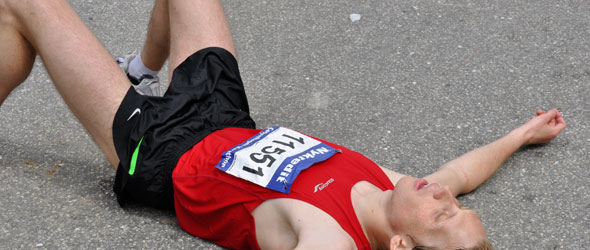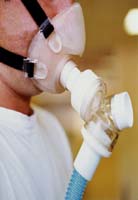Post run stiffness by Doctor Andrew Bosch
Lactic acid build-up is the cause of post hard-run stiffness ……. Wrong! Most runners believe that the stiffness and muscle pain felt after a marathon or hard run is caused by lactic acid. While this was believed correct some decades ago, we now know that lactic acid, or more correctly, lactate, is not the cause of stiffness.
Although the precise cause of delayed onset muscle soreness remains unknown, all runners are aware that the degree of pain depends on the intensity and duration of the run. For example, you have probably noticed that your muscles are more painful after a long or hard downhill run than after running over flat terrain. Comrades runners, particularly, will have noticed that the post-race stiffness is worse after a “down” run than an “up” run. In fact, it is this very phenomenon that begins to exclude a build-up of lactic acid as a cause of the pain. In downhill running the concentration of lactate in the blood and muscle is very low compared to running at the same speed on the flat. Thus, the most painful post-race stiffness occurs when the lactate concentration is lowest.
If we take a blood sample from a runner the day after a marathon, especially an ultra-marathon such as the Two-Oceans or Comrades, we find that the levels of an enzyme called creatine kinase are very high. This is a marker of muscle damage as this particular enzyme “leaks” from damaged muscle. The “damage” is in the form of minute tears or ruptures of the muscle fibres. We can see this trauma to the muscle if a sample of muscle is examined microscopically.
However, it is not just the muscle that is damaged. By measuring hydroxyproline, it is possible to show that the connective tissue in and around the muscles is also disrupted. What this shows is that stiffness results from muscle damage and breakdown of connective tissue.
Running fast or running downhill places greater strain on the muscle fibres and connective tissue compared with running over a flat route. Downhill running is particularly damaging because of the greater so-called eccentric muscle contractions that occur. When your foot contacts the ground after the air-borne phase of the gait cycle, the muscles in the thigh contract to support you. But the nature of the running action is such that although the muscle is contracting, it is forced to lengthen at the same time. It is this simultaneous contracting while lengthening that is called an eccentric contraction and is most damaging to muscle fibres.
What does this mean for the runner? Firstly, after the muscles have recovered from the damage that caused the stiffness and the adaptive process is complete, the muscle is more resistant to damage from subsequent exercise for up to six weeks. It may therefore be beneficial to include a short downhill race or training run 4 to 6 weeks prior to a race such as the Two-oceans or Comrades. Secondly, allowing adequate recovery after a marathon that has resulted in post-race soreness is important so as to allow complete healing to take place so that you can benefit by being “stronger” than before. Thirdly, a well-trained muscle is less prone to damage than a lesser trained one, so hard but scientific training is important.
It has been suggested that vitamin E may help to reduce muscle soreness, but there is little evidence to support this idea. Vitamin E is thought to act as an antioxidant that may blunt the damaging action of free radicals that attack the cell membrane of the muscle fibre. It has also been suggested that stretching the painful muscle or muscles may be beneficial, but this has not consistently been shown to alleviate delayed onset muscle soreness. Similarly, an easy “loosening up” run “to flush out the lactic acid” is unlikely to speed up recovery. To the contrary, running when the muscle is still damaged may delay full recovery. I often tell runners that while it is possible to run when there is still some post run stiffness, they will be running better some weeks later if they delay their return to full training until they no longer feel sore.
The real cause of muscle stiffness after a hard run is clearly not due to lactic acid in the muscle. Once this is well known, runners will be in a better position to manage their return to normal training after a marathon.
View the articles:































Is the stiffness age related at all? Was wondering if younger runners/athletes showed less stiffness & soreness?
Do you also get the same stiffness when working out for short distance training? e.g. Sprinting & also the field disciplines?
Age does have an effect on stiffness, to the point that your muscles do not recover as quickly as you get older. Doing exercise when unfit will also lead to more muscle fatigue which is associated to stiffness. AN unfit person sprinting, may have more muscle damage than mild running / jogging. Hope this helps a little.